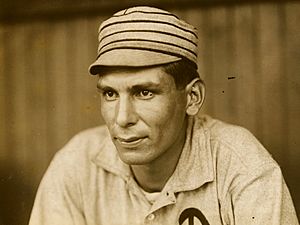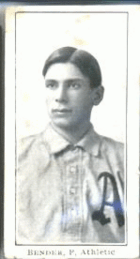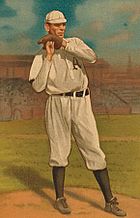Chief Bender facts for kids
Quick facts for kids Chief Bender |
|||
|---|---|---|---|

Chief Bender in 1911
|
|||
| Pitcher | |||
| Born: May 5, 1884 Crow Wing County, Minnesota, U.S. |
|||
| Died: May 22, 1954 (aged 70) Philadelphia, Pennsylvania, U.S. |
|||
|
|||
| debut | |||
| April 20, 1903, for the Philadelphia Athletics | |||
| Last appearance | |||
| July 21, 1925, for the Chicago White Sox | |||
| MLB statistics | |||
| Win–loss record | 212–127 | ||
| Earned run average | 2.46 | ||
| Strikeouts | 1,711 | ||
| Teams | |||
|
|||
| Career highlights and awards | |||
|
|||
| Induction | 1953 | ||
| Election Method | Veterans Committee | ||
Charles Albert "Chief" Bender (born May 5, 1884 – died May 22, 1954) was an amazing American professional baseball pitcher. He played in Major League Baseball during the early 1900s. In 1911, Bender set a record by pitching three complete games in one World Series. He ended his career with 212 wins and only 127 losses. This gave him a great winning percentage of .625. His career earned run average (ERA) was also very low at 2.46.
After his playing days, Bender continued in baseball. He worked as a coach, a manager, and a scout. He was voted into the Baseball Hall of Fame in 1953. He passed away shortly before his official induction ceremony.
| Top - 0-9 A B C D E F G H I J K L M N O P Q R S T U V W X Y Z |
Life Before Baseball
Bender was born in Crow Wing County, Minnesota. He was a member of the Ojibwe tribe. His father was German, and his mother was part Chippewa. As a child, his name was Mandowescence. This means "Little Spirit Animal" in English.
His family owned land on the White Earth Indian Reservation. This was near Bemidji, Minnesota. His father taught him how to farm there. Bender later graduated from the Carlisle Indian Industrial School. He also went to Dickinson College.
Chief Bender's Baseball Journey
Starting His Major League Career
Bender started playing in the major leagues in 1903. He was only 19 years old. Not many pitchers his age have thrown so many innings. He was very good at not walking batters. This means he threw strikes often.
In 1905, Bender helped his team, the Philadelphia Athletics, win their league. They made it to the World Series. Even though they lost, Bender pitched very well. He threw a complete game shutout in one of the games.
He continued to have strong seasons. In 1910, he led the Athletics to another league championship. He won 23 games and lost only 5. His ERA was an amazing 1.58. The Athletics then won the World Series against the Chicago Cubs. Bender pitched a complete game in the first game.
Later Years and World Series Wins
In 1911, Bender had another fantastic year. He won 17 games and helped the Athletics win their second straight league title. They faced the New York Giants in the World Series. The Athletics won, becoming the first American League team to win two World Series in a row. Bender pitched three complete games in this series. He tied a record for this achievement.
He continued to be a key player for the Athletics. In 1913, he won 21 games. The Athletics won their third World Series in four years. Bender won both of his starts in that series. In 1914, he again led his league in winning percentage. The Athletics won their fourth league title in five years. However, they lost the World Series to the Boston Braves.
After 1914, Bender left the Athletics for another team. He later played for the Philadelphia Phillies. During World War I, he took a break from baseball to work in shipyards.
Throughout his career, Bender had 212 wins and a .625 winning percentage. His ERA was 2.46. He was especially good in the World Series. He won six games and had a 2.44 ERA in five World Series appearances. He completed 9 out of 10 games he started. He also threw a no-hitter on May 12, 1910.
Bender was also a good hitter for a pitcher. He had a batting average of .212. He even hit two home runs in one game in 1906. This was very rare back then.
Playing and Coaching After the Majors
After his time in the major leagues, Bender played in the minor leagues. In 1919, he had an incredible record of 29 wins and only 2 losses. He also worked as a player-manager for a few years.
Later, he became a coach for the Chicago White Sox in 1925. He even pitched in one game that year. From 1924 to 1928, Bender coached the baseball team at the United States Naval Academy. He then coached for the New York Giants. He also managed a minor league team. He returned to the Philadelphia Athletics as a scout, minor league manager, and coach. He worked for them for the rest of his life.
Life Off the Field
Bender was often called "Chief." This was a common nickname for Native American baseball players. He sometimes faced unfair comments from fans and other players. People would yell mean things at him. But Bender usually stayed calm. He would sometimes even smile at the insults.
Outside of baseball, Bender enjoyed activities like trap shooting, bowling, and golf. He believed shooting helped him train his eyes and stay focused. He also worked in sporting goods stores. He even opened his own store in 1914.
Later Years and Legacy
Later in his life, Bender had a garden in New Jersey. He loved growing fruits and vegetables, especially corn. He worked in his garden almost every day. In 1950, he became the pitching coach for the Athletics. He helped pitcher Bobby Shantz win the American League Most Valuable Player Award in 1952.
Bender faced health problems, including arthritis and cancer. He passed away on May 22, 1954, from prostate cancer. He was buried in Roslyn, Pennsylvania.
Bender was well-liked by his teammates. Many people praised his intelligence. Teammate Ty Cobb called one of Bender's plays "the greatest bit of brainwork I ever saw." Bender was also known for his sharp eyes. He could often tell what pitch an opposing pitcher was about to throw. This helped his teammates.
Some people believe Bender was the first pitcher to use the "slider" pitch. He called it a "nickel curve." He used this pitch to help him throw his no-hitter and win many games.
Bender was voted into the Baseball Hall of Fame in 1953. This was less than a year before he died. His wife, Marie, accepted the award for him. In 1981, he was included in a book called The 100 Greatest Baseball Players of All Time.
See also
- List of Major League Baseball career wins leaders
- List of Major League Baseball annual saves leaders
- List of Major League Baseball career hit batsmen leaders
- List of Major League Baseball no-hitters
Images for kids






